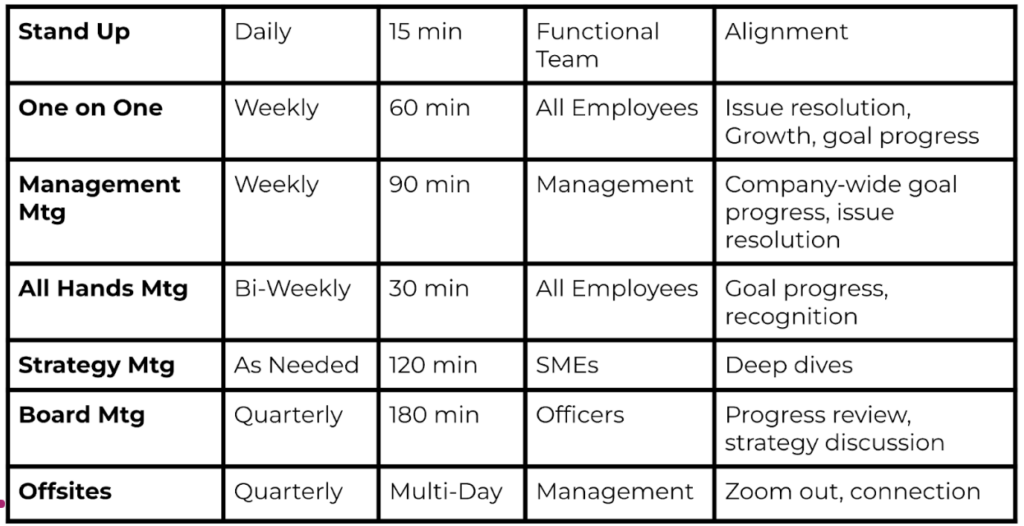When you start a company, your job is to sell a vision.
Then you have to go build something that (if you squint) resembles that vision.
Then you have to win some customers.
And then work tirelessly to delight those customers.
Along the way, you’re going to need a lot of help. And along the way, you will have to continuously answer this question: “How do I make sure all that help is actually helping?”
Communication is easy when it’s just you. It’s still easy with one or two others.
But what about when you reach 10 people?
Or 20?
Or 200?
Or 2,000?
The funny thing is that founder after founder we meet at Enjoy the Work faces the same dilemma. They aspire to build a giant company. One that resembles Airbnb or Uber or Coinbase. And those companies have thousands of employees (6,800, 33,000, and 4,500, respectively, in fact). But when I ask those founders:
If you had thousands of employees today, would you know how to manage them? (The answer is no.)
And do you know how you’re going to learn those skills along the way? (Also no.)
Well, this post is not going to fill all the gaps. But at least it can soften some of the harsh edges.

Becoming an evolutionary leader
The simple truth is that the habits or rituals that worked in the early days of company building are going to break. And then break again and again.
And that’s why the bigger the company gets, the more your job as CEO narrows to a single responsibility. While you might have once been the saleswoman, the product leader, the capital raiser, or the primary recruiter … the more people join your company, the more and more you become the head of communications.
And it’s your job to make sure the right people get the right information at the right time, in the way they need to hear it, see it, read it, or watch it.
That’s a lot, right?
Let’s start with a simple question: Is your company’s current communication architecture working?
Imagine a 1–10 scale:
- 1 = Goals are unclear. Measurements are unclear. People often miss important information and are regularly surprised by things happening across the company. Most (if not all) meetings are more painful than productive. And knowledge is shared through stories rather than robust systems.
- 10 = Everyone in the company knows what’s most important to accomplish. Reporting against KPIs is automated, timely, and universally accessible. People are in the loop when they need to be; new learnings are captured from all across the org and distributed in a highly programmatic manner. Distractions are minimized. When humans do need to meet, those sessions are highly effective. (And dare I say enjoyable?)
Not at a 10 yet? That’s OK. Almost no one is … the pursuit of utopia is the point, even if the destination always feels just out of reach.

The 4 pillars of effective internal comms: finding your rhythm
Most startups live in a perpetual place of being 18 to 24 months from running out of capital. Knowing how you’re going to maximize your progress, growth, learning, and decision-making in those months can be the difference between a sustainable business and a dead one.
Well-run startups have a rhythm. We’ve talked about this before.
What is rhythm?
It is a cadence. A discipline. It’s a clean throughline running back from the next major milestone to the priority work that would deliver that milestone to the financial plan that allocates precious resources to the team so it can execute, learn, communicate, and execute again.
The critical foundation supporting your startup’s vital work? The communication rituals you have in place. In effective internal comms, there are 4 foundational pillars: alignment, feedback, connection, and resolution. Every time you meet, send an email, or put out a dashboard, you do so in service to one (or more) of the 4 pillars.
1. Alignment
As CEO, your job is to ensure alignment. But what is that?
Having alignment across a team means all of the parts of your org work in synchronicity with one another toward a common goal.
Creating alignment involves having your team understand 1), what is most important to accomplish now and (2), why those are the most important things.
But alignment is a bidirectional activity. Leadership has a point of view. And so do members of the team. The best leaders listen … a lot. Because anytime a leader is talking, they are not learning.
So alignment is not simply announcing which hill to climb and why — it’s hearing opinions from the team on whether they agree with the hill, the reasons for climbing it, and what dangers might exist along the way.
Summary — the key elements of alignment:
- Everyone understands the why.
- Everyone feels heard.
- Everyone feels free to express their views, even when they’re contrarian.
- Everyone agrees on success metrics.
- Everyone agrees upon the actions required to deliver those metrics.
2. Feedback
Do you know what’s working? Or, even more importantly, what’s not working? Do you know how to share that knowledge across roles? Departments? The company?
Good feedback is blameless, routine, and delivered both via formal and informal channels. All feedback fits into 4 categories.
Retrospective. A fancy word for “What happened?” Done well, it separates problems from people. People are made to feel safe. What worked and did not work is shared openly, dissected ruthlessly, and documented meticulously. The most common applications involve specific projects, launches, deployments, etc.
Relationship. Working with other people can really suck sometimes. But by examining the ways in which it sucks (or the ways in which it’s glorious), you can build better relationships. And if people trust each other — they share feedback, ask for help, offer help, and collaborate far more readily.
Role. People need to know how they’re doing. And they need to be coached. No one should be surprised by a promotion, a performance review, or (aside from reductions in force) a firing because, ideally, all of those things were preceded by copious and radically candid feedback.
Performance. You’ve set goals. You have metrics. And you have identified actions (and supporting resources) to realize those outcomes. At both the company-wide and department levels, having rituals for measuring against desired (and historical) performance is a critical startup muscle.
Summary — the key elements of feedback:
- It’s blameless — problems are separated from people.
- It’s regular — people know how they’re performing.
- It’s ruthless — the performance of projects, products, deployments, etc., are dissected and documented to inform the future.
- It’s relational — it builds trust and makes collaboration appealing across the org.
3. Connection
When we communicate with our colleagues — regardless of medium — we do so in one of two styles. It might be relational. Or it might be transactional. Both are critical. However, too often companies only formalize the latter.
Transactional communication is all about the task. When will a task be done? Can you assist me with something? Is the new project underway yet? Relational is all about the human. How are you? How’s your family? How are you settling into a new role? Or a new city? Or feeling about a recent re-org?
If I know the people around me, not just their to-do lists, then I’m far more likely to care about them. If I care about them, I’ll look for ways to help. To engage. To build something together. And I’ll feel safe doing so. And when I feel safe, I’ll share openly. The good, the bad, and even the ugly. And that means we all learn and move faster.
Summary — the key elements of connection:
- Communication at work is either transactional or relational.
- Transactional comms are about the task.
- Relational comms are about the humans doing the tasks.
- Making space for connection feeds the relational bucket, which builds a culture of shared purpose and psychological safety.
4. Resolution
Leaders make lots of decisions. But they tend to fall into 3 categories — strategic, human, and tactical.
First, there are strategic decisions. Should we go left or right? Push for growth or lengthen runway? Stay in our current market or pivot? Rely on our current platform or rebuild our underlying tech? Raise further capital or seek an exit? These decisions are rarely straightforward. More often than not, the members of the leadership team are split. The CEO’s job is to place a bet and make a call.
But not all tiebreakers relate to strategy.
Sometimes the conflict will be more about the people than the work. Examples include internal transfers, promotions, project owners, meeting attendees, and offsite participants. There is no path that pleases everyone (and trying to is likely a mistake).
Lastly, there’s tactical problem-solving. In any given week, your company might be hosting an event, attending a conference, launching a marketing promotion, or choosing a new office location. These tend to be straightforward and more urgent than important.
The key elements of resolution:
- Ultimately, leaders are the tiebreakers.
- Decisions fall into 3 categories — strategic, human, and tactical.
- Resolution comms end discussions and move topics forward.

The bones of a well-built communication architecture
The leg bone is connected to the hip bone… If you want your communications to stand up under pressure, there are 5 artifacts to build and disseminate. We’re not sitting around the fire pit telling stories anymore.
Storytelling alone is not enough to do this well — codification supports dissemination.
Artifacts tell you where you’ve been and guide where you’re going.

The 5 artifacts: vision/mission/values, an org chart, a meeting calendar, a Wiki, and a KPI dashboard.
1. Vision/mission/core values: why your business exists, what it does, and how your people show up.
Vision Statement — why your business exists. People at startups work hard. Insanely hard. And it’s not for the compensation, which if translated into an hourly rate, would serve as a call to arms for most union organizers. Why do people work this hard? Because they believe in the why.
Mission Statement — what your business does to deliver the vision. This document provides the compass (and guardrails) for what the team will build, sell, and support. And equally importantly, what they won’t.
Core Values — this is how you want your people to show up. At Enjoy The Work, we have 7 values (though one is hidden from the public), and they guide how the members of our team treat themselves, each other, and our founders. If curious, they are available for all to see.
2. The org chart: Who reports to whom?
Your org chart is not just for board meetings or so that HR has a census. Your org chart reflects your priorities. It conveys how decisions get made. It points to how collaboration occurs.
Are you hierarchical?
Are you matrixed?
Are you flat?
A hierarchical structure is the most traditional.
The CEO is at the top, and information flows from the top down. A hierarchical structure provides clarity around roles and responsibilities. Everyone knows who’s in charge. Everyone knows who’s accountable for what.
But its rigidity can create silos, and the tradeoff might be innovation and collaboration. Cross-departmental comms can suffer as information first flows up in a department before flowing across a leadership team and back down via sister departments. Lots of opportunities for distortion or loss.
The matrix structure is designed to limit hub-spoke bottlenecks. It encourages cross-departmental collaboration and spontaneous cross-functional work.
It’s adaptable, flexible, and fosters omnidirectional communication.
But, as you’ve probably already imagined, it can create confusion and conflict. When there are competing priorities, decision speed can suffer.
The flat organizational structure is designed to bring the clarity of the hierarchical model without adding the complexity of a matrix.
As the name implies, there are no (or few) levels of management between executives and individual contributors. With fewer barriers to communication flows, decision-making can be swift. Collaboration is built in. And innovative ideas, which are often born from collaboration, have a chance to gestate.
But fewer levels to the org means fewer chances for people to advance. Fewer members of management can lead to a high ratio of FTEs to leaders — the result can be fewer 1–1s, less space for relational communications, and ultimately, a less connected team.
*I recognize that there are many more possible organizational structures than the 3 listed above; I chose these 3 because 1), they are the most common and 2), the point I wish to make is that an org chart is a strategic decision and a core artifact of a comms architecture. I’m not advocating for one structure over another — that’s for a different post.
3. The meeting calendar: When to meet and why.

Here are your meeting staples:
- The standup. Daily standups within each functional team create alignment.
- The one-on-one. Weekly one-on-one meetings between managers and their direct reports foster connection, personal growth, issue resolution, and goal progress.
- The leadership meeting. Weekly management meetings ensure alignment, drive company-wide progress, and make space for rapid issue resolution.
- The all-hands. Short, biweekly all-hands meetings ensure alignment and celebrate achievements.
- The strategy meeting. Single-topic deep dives.
- The board meeting. This is your (typically) quarterly review of the business performance and a strategy discussion.
- The offsite. Periodic in-person meetings in which you craft long-term strategy, build connection, and deepen team cohesion.
4. The knowledge database/Wiki: a searchable archive of all of the useful knowledge of your business.
How do humans actually share knowledge?
First, there were stories. Cave drawings. Ink to animal skin. Then that guy Gutenberg came along, and there was print. Then we could take notes electronically and even collaborate on them! But now: Now we have a Wiki.
Confluence, Guru, Notion, Document360, Stack Overflow. I’m platform agnostic, but every well-run company finds a way to collaboratively gather, edit, and share institutional knowledge.
How to win with a Wiki:
Structure it.
Before you start building your Wiki, outline it, structure it, and obsess over your users. Create knowledge domains and subdomains that will help your team quickly navigate to the information they need.
Capture retrospectives.
Capturing your retrospectives allows everyone in your company to learn from things that went terribly wrong (and hopefully keeps them from making the same mistakes). Everything is a lesson or an example. Prove it by keeping the records.
Have dedicated editors.
Everyone should be able to contribute to your Wiki. But you need people who are responsible for regularly going through the content, editing it, structuring it, and making sure it’s in the right place. Find the person who LOVES this type of work. They are rare and precious creatures. Libraries need librarians.
Use keywords.
The search tools on most Wiki are fairly unsophisticated. Similar to being thoughtful about how you structure your documents in the Wiki, you can create a mechanism to tag important documents. If done intelligently, search will surface important documents first.
Enforce a Wiki-first policy.
Don’t let important information get lost in Slack or email. Be ruthless about this. If the leaders behave this way — everyone will.
Create a living document.
Your Wiki is like a garden. If your team tends to it, it will grow and bear fruit. If your team doesn’t, it will whither. Imagine how good your organizational memory (and onboarding capabilities) would be if after you ramped each new hire, you asked them (within the Wiki) to improve onboarding for the next hire…
5. The KPI dashboard: What are you measuring (and not measuring)?
KPI stands for Key Performance Indicator. Please pay attention to the first word. I know in our current business environment, we can measure every log in, every click, every mouse shift, or even every eye movement. But not everything is “key.” Here’s how to make sure you’re capturing the most important metrics and empowering people to use them.

1. Focus: Include 30% fewer metrics than you want.
All of us have metrics that matter more than others. Orient leaders on what’s important and actionable. What is the health of our business? What is the health of our product and operations? What is the health of our team?
2. Offer comparison over time.
Provide context and comparisons to your numbers. People looking at the dashboard should immediately know whether the number is good or bad, better or worse, ahead or behind. They should be able to see how it compares month over month, year over year, and versus plan.
3. Obsess about ease of interpretation.
Imagine the KPI dashboard is your product and the people reading it are your users. Make it easy to use and effective.
If time has to be spent interpreting the dashboard, then you still have work to do.
4. Serve your audience.
Your company will have many dashboards. Start with your executive leadership version (and share it with your board of directors). Model the behavior for your department heads. Every dashboard should be built with the user in mind.

Where all of this is headed …
Imagine everyone on your team knowing what they need to know when they need to know it.
Wouldn’t work just flow? No bottlenecks, no frustration, no gaps in knowledge. Just time spent with similarly motivated humans trying to solve hard problems to deliver the change you hope to see in the world. Sounds lovely, right?
And isn’t that why you started this whole damn journey in the first place?
